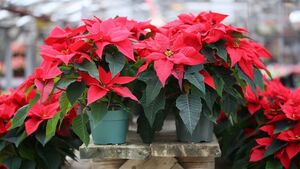Green Fingers: Discovering deadly plants around Halloween

Some of the most popular houseplants are toxic, such as poinsettia, which has toxic sap.
Most people like to spend time in the great outdoors enjoying nature and the benefits are well known. It is also a fact that there are a large range of plants that could be considered deadly and can have a negative effect on us one way or the other.
I should think that most of us regard our garden plants and those in the wild as generally harmless and that view continues as we further lose our connection with nature and are tending to look at the outside world in a more detached manner.
While we might be a bit naive about what can or cannot be used in the wild for consumption, there is fortunately an inbuilt resistance to try anything at all due to ignorance and, luckily, that is why there are very few bad reactions or worse due to eating or handling a deadly wild plant.
There are quite a number of native mushrooms or fungi that can be eaten and enjoyed but, barring a few distinct types such as the field mushrooms, which we pick around September, the remaining types, which are encountered, are best left to knowledgeable people to identify.
In parts of Europe, where there is still a strong attachment to the countryside, huge numbers of mushrooms are consumed with relish each year as part of their seasonal delight.
There are a number of plants which, if touched, will bring out a rash in you. The obvious example is the nettle, but there are others, including some garden plants, which can affect some people, while others are immune.
The native Giant Hogweed found in some localities might, if put to the lips, cause swelling, and the ‘Stag's Horn Sumach’, called Rhus, can cause a skin irritation. ‘Monkshood’ or aconitum, Daphne, Delphinium, ‘Lily-of-the-Valley’, ’Bleeding Heart’ or Dicentra and hyacinths can all cause skin irritations and other problems, but, in practice, casual handling does not cause problems as it needs a higher dosage to have any harmful effect.
Some plants grown in tropical countries have contributed to the deterioration in the health of huge numbers of people. The coca plant, from which cocaine is derived, is one, as is the cannabis plant (marijuana), opium poppy (heroin) and tobacco.
Oddly, some of the most popular houseplants are toxic but, in practice, it is not a problem unless they are treated differently than just admired for their beauty.
The poinsettia is one, which has toxic sap, the peace lily, ivy (hedera helix), philodendron, ficus (rubber plant) and Christmas cherry can all cause problems if the sap reaches the eyes, mouth and other sensitive areas of the body.
Some common food crops, unless cooked or treated in a certain way, can cause problems but this is generally common knowledge and people take it for granted which parts of a plant to eat.
Rhubarb stalks are fine but the leaves are not as they contain high levels of oxalic acid, while potatoes contain solanine, which is mostly killed off by cooking, but do not use potatoes whose skin is green from exposure to the light.
Tomato leaves, stems and green fruit contain small amounts of tomatine, whereas ripe tomatoes do not contain detectable amounts.
It is coming to the end of the road for half hardy vegetables such as tomatoes, aubergines, courgettes, cucumbers and peppers. You might as well save or use what you can of these crops, and then throw all the surplus foliage onto the compost heap or into bin bags, and tie the top when filled so the contents can mature and rot away and be available as compost next spring.
If you have any queries or comments you are welcome to share them with me on 051 384273 or orchardstowngardencentre@hotmail.com and if of general interest I will include it in a future article.






